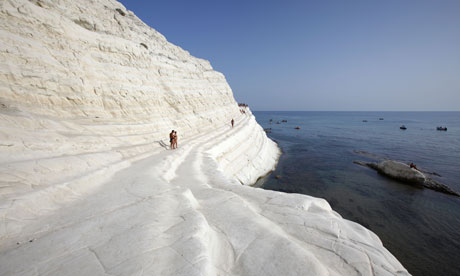
Sunlight bounces off the chalky white rocks beneath my feet, hurting my eyes so that I look away, upwards, towards the sky. A man stands on the tip of an outcrop high above – muscular, nut brown, and in a pair of Speedos as white as the cliffs. He seems to be channelling the Greek gods who once walked this shoreline, but is being ignored by the cute girls down at my level, their faces patched with dried mud. He strikes another pose. It's a spring Sunday in Sicily.
I am on the Turkish Steps, on Sicily's southern shore. My lady had said: "Let's go for a long weekend somewhere that's easy to get to, with great food, lovely beaches and maybe a bit of culture."
Arriving in Palermo on a brutishly early but otherwise painless Ryanair flight – "C'mon, for £100 return we can endure this" – we rent a car for the 80-mile journey over the back of the island, passing combine harvesters working the parched fields, and put up at Mandranova, an agriturismo, or farm with rooms, owned by Silvia and Giuseppe di Vincenzo.
It's disconcertingly close to the main coast road, but once we are beyond the gates and into the olive groves, being led through the heat into the whitewashed farm buildings and offered a lunch of a perfect salad and cold wine, all concerns evaporate.
When Giuseppe is not dealing with the olive harvest, he is planning ways to improve the property, poring over design magazines, while Silvia spends the whole day preparing the shared evening meal. We leave them to it and climb the hill behind the house to lie beside the converted irrigation cistern – the gebbia – which is now a gorgeously paved freshwater pool overlooking the olive groves.
The rooms are huge, cool and soothing shelters from the heat, minimally appointed under plain wooden ceilings – a place of rest before the baroque assault of dinner. Among the many extraordinary dishes – salads prepared from sun-blessed ingredients, grilled fish, herbed and roasted meat — is a "leopard cake", a version of a dish served in di Lampedusa's The Leopard. It is vegetable-baked pasta, which sounds mundane but is anything but. It had taken hours, according to the guests who had taken the cookery lessons, and was a many-layered thing of treasures.
The following morning we head for the sea. The temperature is already into the high 30s. Although there are numerous sandy beaches (or, alternatively, a day on Giuseppe's boat, which is very Dolce Vita with extra lashings of fresh tomato pasta and fine white wine), we go to the Turkish Steps. They are less beach and more long, smooth marl terraces behind which Barbary pirates used to hide from the storms. The white stone is pleasing underfoot. Water gurgles at the cliff edge, pushing through a narrow channel where teenage boys leap and frolic in their attempts to impress the girls. For their part the girls sit together in the shallows to work on their beauty programmes, grinding lumps of the rock into mud and lathering themselves with it. (I've always admired the Italian habit of grouping at the beach. We Brits lay out our towels as far from the next bather as possible, but the Italians can't bear that, preferring to create a carry-on.)
Having swum and sunbathed away the heat of the day, we head to the Valley of the Temples, Agrigento's park of Greek ruins. The finest sit high on a ridge so that sailors in 500BC could see their outlines as they returned home; for the rest of us the outline of the best preserved – the Temple of Concordia – is equally well known, as it has become the logo used by Unesco.
Even in spring, the right time to walk among them is the evening. The Temple of Concordia has survived because its architects built it on a layer of clay that saved it from earthquakes, and then in 600AD Christians decided to convert it, rather than destroy it. At sunset, looking through its great pillars, I feel that profound sense of wonder, the weight of the sublime, that catches me when I am in great wildernesses, only here is a nature of our creating.
A little shaken by having a (rare) emotion, I suggest we head down to the coastal village of San Leone, a slightly grisly resort on the coast. Giuseppe had recommended a restaurant, Trattoria Caico, for its well-priced seafood. It is full of Sicilians demanding the enthusiastic owner show off his market skills by carrying the fresh carcasses of fish to their tables, to present to them. This is eating.
The road home to Mandranova is enclosed in the warm cloak of night as we set off. It takes us back through the Valley of the Temples. Sated on seafood, the sun having made our skin tingle, we pass just before midnight under the floodlit temples, and look up at our history written on the skyline.
Essentials
Ryanair (ryanair.com) flies to Palermo from £58. Europcar hire costs from £23.04 per day (europcar.co.uk). Double rooms at Mandranova cost from €120 per night (mandranova.it). The boat trip costs €60 per person, while cookery courses at the resort cost €70 per person

